Applied Mathematics and Mechanics (English Edition) ›› 2025, Vol. 46 ›› Issue (7): 1383-1402.doi: https://doi.org/10.1007/s10483-025-3271-6
Previous Articles Next Articles
M. USMAN1, M. HAMID2,3,†( ), W. A. KHAN4, R. U. HAQ5
), W. A. KHAN4, R. U. HAQ5
Received:2025-01-24
Revised:2025-05-11
Published:2025-06-30
Contact:
M. HAMID, E-mail: mhamid@pku.edu.cnSupported by:2010 MSC Number:
M. USMAN, M. HAMID, W. A. KHAN, R. U. HAQ. Hydrodynamical characterization of nanofluidic flow driven by forced convection via a four-sided lid-driven cavity. Applied Mathematics and Mechanics (English Edition), 2025, 46(7): 1383-1402.
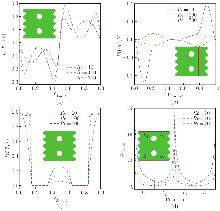
Fig. 6
Effects of Re on (a) the velocity profile U along the X-axis when Y=0.9, (b) the velocity profile V along the Y-axis when X=0.75, (c) the temperature profile T along the Y-axis when X=0.5, and (d) the local Nusselt number on the heated walls, when Pr=6.2, Ri=0.01, Da=−10, ϕ=0, U1=U3=1, U2=U4=−1, and Q=5 (color online)"

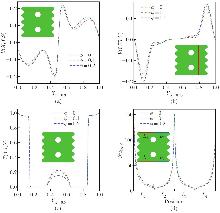
Fig. 8
Effects of ϕ on (a) the velocity profile U along the X-axis when X=0.5, (b) the velocity profile V along the Y-axis when X=0.75, (c) the temperature profile T along the Y-axis when X=0.5, and (d) the local Nusselt number on the heated walls, when Pr=6.2, Ri=0.01, Re=500, Da=−10, U1=U3=1, U2=U4=−1, and Q=5 (color online)"

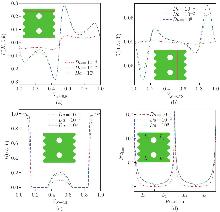
Fig. 11
Effects of Da on (a) the velocity profile U along the X-axis when Y=0.9, (b) the velocity profile V along the Y-axis when X=0.75, (c) the temperature profile T along the Y-axis when X=0.5, and (d) the local Nusselt number on the heated walls, where Pr=6.2, Re=250, Ri=0.01, ϕ=0, U1=U3=1, U2=U4=−1, and Q=5 (color online)"

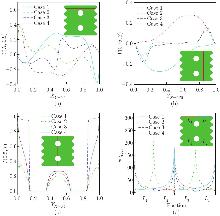
Fig. 13
(a) Velocity profile U along the X-axis when Y=0.9, (b) velocity profile V along the Y-axis when X=0.75, (c) temperature profile T along the Y-axis when X=0.5, and (d) local Nusselt number on heated walls when U1=U2=−U3=−U4=1 (Case 1), −U1=U2=−U3=U4=1 (Case 2), U1=−U2=U3=−U4=1 (Case 3), and U1=U2=−1, U3=U4=1 (Case 4), where Pr=6.2, Ri=0.01, Da=−10, Re=550, ϕ=0, and Q=5 (color online)"

| [6] | BHOPALAM, S. R., PERUMAL, D. A., and YADAV, A. K. Computational appraisal of fluid flow behavior in two-sided oscillating lid-driven cavities. International Journal of Mechanical Sciences, 196, 106303 (2021) |
| [7] | SOOMRO, F. A., HAMID, M., HUSSAIN, S. T., and HAQ, R. U. Constructional design and mixed convection heat transfer inside lid-driven semicircular cavity. European Physical Journal Plus, 137(7), 781 (2022) |
| [8] | KHAN, Z. H., KHAN, W. A., QASIM, M., ALHARBI, S. O., HAMID, M., and DU, M. Hybrid nanofluid flow around a triangular-shaped obstacle inside a split lid-driven trapezoidal cavity. European Physical Journal Special Topics, 231(13), 2749–2759 (2022) |
| [9] | AHMED, S. E., RAIZAH, Z., ARAFA, A. A. M., and HUSSEIN, S. A. FEM treatments for MHD highly mixed convection flow within partially heated double-lid driven odd-shaped enclosures using ternary composition nanofluids. International Communications in Heat and Mass Transfer, 145, 106854 (2023) |
| [10] | AHMED, S., CHEN, Z. M., XU, H., and ISHAQ, M. Mixed convection flow in a square lid-driven cavity subject to inclined magnetic field with highly accurate wavelet-homotopy solutions. Computers & Mathematics with Applications, 162, 33–51 (2024) |
| [11] | TAYEBI, T. and CHAMKHA, A. J. Magnetohydrodynamic natural convection heat transfer of hybrid nanofluid in a square enclosure in the presence of a wavy circular conductive cylinder. Journal of Thermal Science and Engineering Applications, 12(3), 031009 (2020) |
| [12] | HASHEMI-TILEHNOEE, M., DOGONCHI, A. S., SEYYEDI, S. M., CHAMKHA, A. J., and GANJI, D. D. Magnetohydrodynamic natural convection and entropy generation analyses inside a nanofluid-filled incinerator-shaped porous cavity with wavy heater block. Journal of Thermal Analysis and Calorimetry, 141(5), 2033–2045 (2020) |
| [13] | SEYYEDI, S. M., DOGONCHI, A. S., HASHEMI-TILEHNOEE, M., GANJI, D. D., and CHAMKHA, A. J. Second law analysis of magneto-natural convection in a nanofluid filled wavy-hexagonal porous enclosure. International Journal of Numerical Methods for Heat & Fluid Flow, 30(11), 4811–4836 (2020) |
| [14] | ALSABERY, A. I., TAYEBI, T., KADHIM, H. T., GHALAMBAZ, M., HASHIM, I., and CHAMKHA, A. J. Impact of two-phase hybrid nanofluid approach on mixed convection inside wavy lid-driven cavity having localized solid block. Journal of Advanced Research, 30, 63–74 (2021) |
| [15] | CHAMKHA, A. J., HUSSAIN, S. H., and ABD-AMER, Q. R. Mixed convection heat transfer of air inside a square vented cavity with a heated horizontal square cylinder. Numerical Heat Transfer, Part A: Applications, 59(1), 58–79 (2011) |
| [1] | ULLAH, M. Z., HUSSAIN, S. T., HAQ, R. U., ALZAHRANI, A. K., and MALLAWI, F. Thermal energy performance due to convection process of nanofluid in a porous medium due to split lid motion in a right triangular enclosure. Journal of Computational Design and Engineering, 9(3), 890–906 (2022) |
| [2] | BHATTACHARYA, M., BASAK, T., OZTOP, H. F., and VAROL, Y. Mixed convection and role of multiple solutions in lid-driven trapezoidal enclosures. International Journal of Heat and Mass Transfer, 63, 366–388 (2013) |
| [3] | THAKUR, M. S. H., ISLAM, M., UL KARIM, A., SAHA, S., and HASAN, M. N. Numerical study of laminar mixed convection in a Cu-water nanofluid filled lid-driven square cavity with an isothermally heated cylinder. AIP Conference Proceedings, 2121, 070017 (2019) |
| [4] | KHAN, Z. H., KHAN, W. A., HAMID, M., and LIU, H. T. Finite element analysis of hybrid nanofluid flow and heat transfer in a split lid-driven square cavity with Y-shaped obstacle. Physics of Fluids, 32(9), 093609 (2020) |
| [5] | ALSABERY, A. I., SHEREMET, M. A., SHEIKHOLESLAMI, M., CHAMKHA, A. J., and HASHIM, I. Magnetohydrodynamics energy transport inside a double lid-driven wavy-walled chamber: impacts of inner solid cylinder and two-phase nanoliquid approach. International Journal of Mechanical Sciences, 184, 105846 (2020) |
| [16] | ALSABERY, A. I., MOHEBBI, R., CHAMKHA, A. J., and HASHIM, I. Effect of local thermal non-equilibrium model on natural convection in a nanofluid-filled wavy-walled porous cavity containing inner solid cylinder. Chemical Engineering Science, 201, 247–263 (2019) |
| [17] | KHAN, Z. H., KHAN, W. A., SHEREMET, M. A., HAMID, M., and DU, M. Irreversibilities in natural convection inside a right-angled trapezoidal cavity with sinusoidal wall temperature. Physics of Fluids, 33(8), 083612 (2021) |
| [18] | HAMID, M., KHAN, Z. H., KHAN, W. A., and TIAN, Z. F. Natural convection inside a trapezoidal cavity under multidirectional magnetic impacts: finite element characterization. Physics of Fluids, 35(9), 093618 (2023) |
| [19] | HAMID, M., USMAN, M., KHAN, W. A., HAQ, R. U., and TIAN, Z. F. Natural convection and multidirectional magnetic field inside a square shaped cavity with sinusoidal temperature and heated/cold blocks. International Communications in Heat and Mass Transfer, 152, 107291 (2024) |
| [20] | HAMID, M., USMAN, M., KHAN, W. A., HAQ, R. U., and TIAN, Z. F. Characterizing natural convection and thermal behavior in a square cavity with curvilinear corners and central circular obstacles. Applied Thermal Engineering, 248, 123133 (2024) |
| [1] | Zhiwen FAN, Hai QING. Size-dependent bending and vibration analysis of piezoelectric nanobeam based on fractional-order kinematic relations [J]. Applied Mathematics and Mechanics (English Edition), 2025, 46(7): 1261-1272. |
| [2] | S. SAURABH, R. KIRAN, D. SINGH, R. VAISH, V. S. CHAUHAN. A comprehensive investigation on nonlinear vibration andbending characteristics of bio-inspired helicoidallaminated composite structures [J]. Applied Mathematics and Mechanics (English Edition), 2025, 46(1): 81-100. |
| [3] | M. IBTESAM, S. NADEEM, J. ALZABUT. Numerical computations of magnetohydrodynamic mixed convective flow of Casson nanofluid in an open-ended cavity formed by earthquake-induced faults [J]. Applied Mathematics and Mechanics (English Edition), 2024, 45(12): 2215-2230. |
| [4] | J. A. OTERO, Y. ESPINOSA-ALMEYDA, R. RODRÍGUEZ-RAMOS, J. MERODIO. Semi-analytical finite element method applied for characterizing micropolar fibrous composites [J]. Applied Mathematics and Mechanics (English Edition), 2024, 45(12): 2147-2164. |
| [5] | Pan WANG, Xiangcheng HAN, Weibin WEN, Baolin WANG, Jun LIANG. Galerkin-based quasi-smooth manifold element (QSME) method for anisotropic heat conduction problems in composites with complex geometry [J]. Applied Mathematics and Mechanics (English Edition), 2024, 45(1): 137-154. |
| [6] | Chenxue JIA, Zihao WANG, Donghui ZHANG, Taihua ZHANG, Xianhong MENG. Fracture of films caused by uniaxial tensions: a numerical model [J]. Applied Mathematics and Mechanics (English Edition), 2023, 44(12): 2093-2108. |
| [7] | Wenjie SUN, Wentao MA, Fei ZHANG, Wei HONG, Bo LI. Snap-through path in a bistable dielectric elastomer actuator [J]. Applied Mathematics and Mechanics (English Edition), 2022, 43(8): 1159-1170. |
| [8] | Si YUAN, Quan YUAN. Condensed Galerkin element of degree m for first-order initial-value problem with O(h2m+2) super-convergent nodal solutions [J]. Applied Mathematics and Mechanics (English Edition), 2022, 43(4): 603-614. |
| [9] | S. HUSSAIN, T. TAYEBI, T. ARMAGHANI, A. M. RASHAD, H. A. NABWEY. Conjugate natural convection of non-Newtonian hybrid nanofluid in wavy-shaped enclosure [J]. Applied Mathematics and Mechanics (English Edition), 2022, 43(3): 447-466. |
| [10] | M. KOHANSAL-VAJARGAH, R. ANSARI, M. FARAJI-OSKOUIE, M. BAZDID-VAHDATI. Vibration analysis of two-dimensional structures using micropolar elements [J]. Applied Mathematics and Mechanics (English Edition), 2021, 42(7): 999-1012. |
| [11] | S. NADEEM, S. AKHTAR, A. SALEEM. Peristaltic flow of a heated Jeffrey fluid inside an elliptic duct: streamline analysis [J]. Applied Mathematics and Mechanics (English Edition), 2021, 42(4): 583-592. |
| [12] | M. SHOJAEIFARD, M. R. BAYAT, M. BAGHANI. Swelling-induced finite bending of functionally graded pH-responsive hydrogels: a semi-analytical method [J]. Applied Mathematics and Mechanics (English Edition), 2019, 40(5): 679-694. |
| [13] | Chao XU, Dongyang SHI, Xin LIAO. A new streamline diffusion finite element method for the generalized Oseen problem [J]. Applied Mathematics and Mechanics (English Edition), 2018, 39(2): 291-304. |
| [14] | Jincun LIU, Hong LI, Yang LIU, Zhichao FANG. Reduced-order finite element method based on POD for fractional Tricomi-type equation [J]. Applied Mathematics and Mechanics (English Edition), 2016, 37(5): 647-658. |
| [15] | Jikun ZHAO, Shipeng MAO, Weiying ZHENG. Anisotropic adaptive finite element method for magnetohydrodynamic flow at high Hartmann numbers [J]. Applied Mathematics and Mechanics (English Edition), 2016, 37(11): 1479-1500. |
| Viewed | ||||||
|
Full text |
|
|||||
|
Abstract |
|
|||||

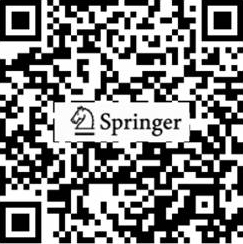
 Email Alert
Email Alert RSS
RSS